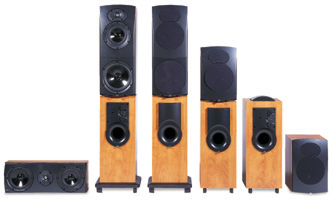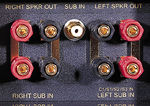Athena Speaker System
Having spent the first 18 years of my life in the great state of Alaska, it seems only natural that I've developed a taste for some of Canada's finer exports. As if hockey, some tasty rye whiskeys, and all that fresh powder that sweeps down upon the western ski resorts from the north weren't enough, the disproportionately high number of quality loudspeakers produced there intrigues me, as well. There may be fewer speaker manufacturers in that entire country than in certain regions of the U.S., but I'll wager that Canada's ratio of solid to subpar speaker offerings will hold its own against any other country in the mix.

Contributing positively to this number is Audio Products International, the parent company behind the loudspeaker monikers Energy, Mirage, Sound Dynamics, and now Athena Technologies—a new brand whose initial speaker lineup stresses flexibility in both form and function. Athena's approach to home theater is a modular one, allowing you to mix and match speaker components according to need, listening preference, and budget.
The line includes three main models—dubbed S3, S2, and S1—that can be run independently via a single pair of speaker-level, five-way binding-post inputs or mated with their corresponding subwoofer unit. The three-way S3 employs a 1-inch dome tweeter, a 5 1/4-inch midrange, and an 8-inch woofer, while the two-way S2 and S1 use a 6 1/2-inch and 5 1/2-inch woofer, respectively, and a 1-inch dome tweeter.
The three active, vertically aligned subwoofer models—P3 (10-inch), P2 (8-inch), and P1 (6 1/2-inch) in ported enclosures—can also be used independently and have two pairs of speaker-level inputs and outputs (offering considerable wiring flexibility) and a line-level RCA input, should you opt for a subwoofer feed from your preamp or receiver. On the front of each sub cabinet are the standard bass-level control and bass-range control to adjust frequency rolloff (continuously variable between 50 and 150 hertz), a three-setting Mode switch that offers S3, S2, and Sub positions (S1 and Sub on the P1) for a more-precise match with the mains or other speakers, and a Blend switch that reverses polarity to help accommodate for different speaker locations and listening-room anomalies. While the bass-level control is always active, the range control and Blend switch operate only when the Mode switch is in the Sub position.
The main speaker connects to the top of the subwoofer via metal docking rails that not only ensure a secure fit between top and bottom but also transfer the audio signal from the sub's inputs to the main unit, eliminating the need for an extra connection. Removable metal jumpers are supplied between the sub's input and output posts to activate the rails' transfer capabilities. Keep in mind that the S3s and S2s can be docked interchangeably with the P3 and P2 subwoofers, while the smaller size of the S1 and P1 units requires that they be joined only to one another.
 As the variety of input and output options on these speakers would indicate, there are a number of different connection scenarios, the full potential of which we can hardly address in our limited space. For this review, we focused on what we assume will be the most common connections for a system consisting of two S3/P3 combos in front, two S2/P2 combos in the rear, and the horizontally aligned C1 center channel—the only current model in the Athena line designed exclusively for standalone use.
As the variety of input and output options on these speakers would indicate, there are a number of different connection scenarios, the full potential of which we can hardly address in our limited space. For this review, we focused on what we assume will be the most common connections for a system consisting of two S3/P3 combos in front, two S2/P2 combos in the rear, and the horizontally aligned C1 center channel—the only current model in the Athena line designed exclusively for standalone use.
The most straight-forward approach is to treat these five units like any other five-speaker home theater array and connect the corresponding speaker-level outputs from the amplifier to the subwoofers' left-sub-in posts on each of the four docked combos and to the single pair of speaker-level inputs on the C1. Assuming that you've selected "large" for the front and rear in your preamp's or receiver's speaker-configuration menu, this connection will run the S3/P3s and S2/P2s full-range and engage their internal crossover networks. Selecting the S3 or S2 setting of the subwoofer's Mode switch supplies factory blending between the main and sub, while the Sub position allows custom tailoring through the range and Blend controls.
Having broken the system in by running a continuous, 200-hour burn-in and firing a couple slapshots its way to make it feel at home, I started my music demo with the most basic connection. One of the first things to jump out at me about this system was its imaging, especially in stereo. After switching out of our reference preamp's (Lexicon MC-1) multi-channel Music Logic mode and in to two-channel, I found myself actually walking over to the center channel to make sure it was no longer producing sound. Needless to say, the stereo imaging of the S3/P3 fronts is rather convincing.
Timbre-matching, while discussed primarily in the context of soundtracks, is obviously important for music, as well, and I was pleased by the consistent character of this system throughout our multichannel music demo. The majestic string compositions from one of 5.1 Entertainment's well-engineered demo discs floated around the room with a natural balance that contributed significantly to the overall sense of realism. The Athenas aren't all finesse, though. The same assessment of timbral accuracy held true with the hard-driving riffs of their fellow countrymen in the band Rush, hinting that these speakers are as flexible in their musical tastes as they are in their deployment. This was two-channel material matrixed to five by the Lexicon, and the Athenas played their part nicely by creating a deep, uniform soundstage.
Bass in a four-subwoofer setup was obviously plentiful—too plentiful for music, in my opinion. Setting aside the problem of standing waves for a moment, I found that the system's low-frequency response was a bit much. It was also somewhat murky before cutting out the P2s by sending the rear connections straight into the S2's inputs. Some of this abundance results from the fact that the main speaker still receives a full-range signal from the sub's outputs when docked. A less bass-heavy alternative is to run a line-level input to the subwoofer and a speaker-level input to the main, with the lower frequencies filtered out by the preamp. Keep in mind, I've never much cared for using subwoofers with music, period. Ultimately, I found that cutting out all of the subwoofers (or all but a single P3) delivered a musical presentation that was much more to my liking. This is the beauty of Athena's modular concept and the options it gives you in determining what, where, when, and how.
Where you're going to want all that teeth-rattling bass is with movie soundtracks, although you'll need to get somewhat creative with your placements to avoid the aforementioned problem of standing waves that can plague multisubwoofer setups. Standing waves are essentially pockets of high and low pressure caused by interference between direct sound and reflected sound from walls, ceilings, floors, etc. This creates peaks and valleys in a room's overall frequency response that will overly emphasize or de-emphasize bass output in different spots. The more subs you use, the more potential you create for standing-wave interference.
This isn't at all to say that a multisubwoofer setup can't sound good; it simply requires a little more effort to dial-in. We were able to do so with quite satisfactory results in our listening room, and the payoff was immediate. I went right for the spellbinding air-cavalry attack early in Apocalypse Now and prepped myself for the ensuing mayhem. It almost goes without saying that, with four subs that can reach down into the underbelly of the frequency range, the pressure in the room during the final napalm strike was intense. Dare I say, it sounded like...victory. (Don't worry, I'll slap myself for that one.)





























































